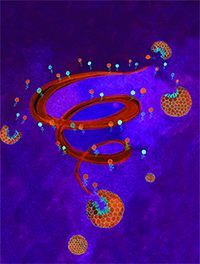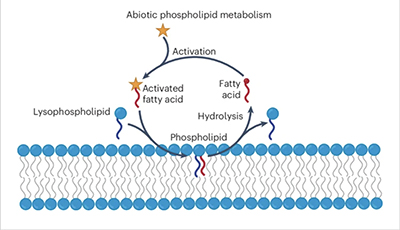On the Origins of Life: Recreating Cellular Metabolism
Researchers have reached a crucial step in understanding how living cells may have evolved from nonliving matter
Story by:
Published Date
Article Content
At some point during the evolution of life on Earth, inorganic matter became organic, nonliving matter became living. How this happened is one of humankind’s greatest mysteries. Today, scientists work to develop synthetic cells that mimic living cells, hoping to uncover clues that will help answer the question: how did life on Earth begin?
While there’s no single definition of life, three elements recur across biology:
- compartmentalization — a barrier that separates a cell’s interior from the environment;
- metabolism — building up and breaking down molecules to carry out cell function; and
- selection — a process in which certain molecules are favored over others.

Artist rendering showing a vortex of energy and how certain lipids and fatty acids come together to form a membrane. The process is cyclical as components come together and separate and energt is added and removed. (cr: Zhen Xu)
In the past, researchers have focused on compartmentalization, but not on metabolism. Yet this cycle of building up and breaking down molecules is a critical aspect of how living cells respond to environmental stimuli, replicate and evolve.
Now researchers from the University of California San Diego have designed a system that synthesizes cell membranes and incorporates metabolic activity. Their work appears in Nature Chemistry and is featured on the cover of the June 2025 issue.
“Cells that lack a metabolic network are stuck -- they aren’t able to remodel, grow or divide,” stated Neal Devaraj, the Murray Goodman Endowed Chair in Chemistry and Biochemistry at UC San Diego and principal investigator on the paper. “Life today is highly evolved, but we want to understand if metabolism can occur in very simple chemical systems, before the evolution of more complex biology occurred.”
Lipids are fatty compounds that play a crucial role in many cell functions. In living cells, lipid membranes serve as barriers, separating cells from the external environment. Lipid membranes are dynamic, capable of remodeling themselves in response to cellular demands.
As a crucial step in understanding how living cells evolved, Devaraj’s lab designed a system where lipids can not only form membranes, but through metabolism, can also break them down. The system they created was abiotic, meaning only nonliving matter was used. This is important in helping understand how life emerged on prebiotic Earth, when only nonliving matter existed.
“We are trying to answer the fundamental question: what are the minimal systems that have the properties of life?” said Alessandro Fracassi, a postdoctoral scholar in Devaraj’s lab and first author on the paper.
The chemical cycle they created uses a chemical fuel to activate fatty acids. The fatty acids then couple with lysophospholipids, which generate phospholipids. These phospholipids spontaneously form membranes, but in the absence of fuel, they break down and return to the fatty acid and lysophospholipid components. The cycle begins anew.
Now that they’ve shown they can create an artificial cell membrane, they want to continue adding layers of complexity until they have created something that has many more of the properties we associate with “life.”

“We know a lot about living cells and what they’re made of,” stated Fracassi. “But if you laid out all the separate components, we don’t actually understand how to put them together to make the cell function as it does. We’re trying to recreate a primitive yet functional cell, one layer at a time.”
In addition to shedding light on how life may have begun in an abiotic environment, the development of artificial cells can have a real-world impact. Drug delivery, biomanufacturing, environmental remediation, biomimetic sensors are all possibilities over the coming decades as we continue to deepen our understanding of how life on Earth came to be.
“We may not see these kinds of advancements for 10 or 20 years,” Devaraj noted. “But we have to do the work today, because we still have so much to learn.”
Authors: Alessandro Fracassi, Andrés Seoane, Hong-Guen Lee, Alexander Harjung and Neal K. Devaraj (all UC San Diego); and Roberto J. Brea (Universidade da Coruña (Spain)).
This work was funded by the National Science Foundation (CHE-2304664).
Share This:
Stay in the Know
Keep up with all the latest from UC San Diego. Subscribe to the newsletter today.



